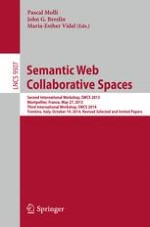2016 | Buch
Semantic Web Collaborative Spaces
Second International Workshop, SWCS 2013, Montpellier, France, May 27, 2013, Third International Workshop, SWCS 2014, Trentino, Italy, October 19, 2014, Revised Selected and Invited Papers
herausgegeben von: Pascal Molli, John G. Breslin, Maria-Esther Vidal
Verlag: Springer International Publishing
Buchreihe : Lecture Notes in Computer Science
